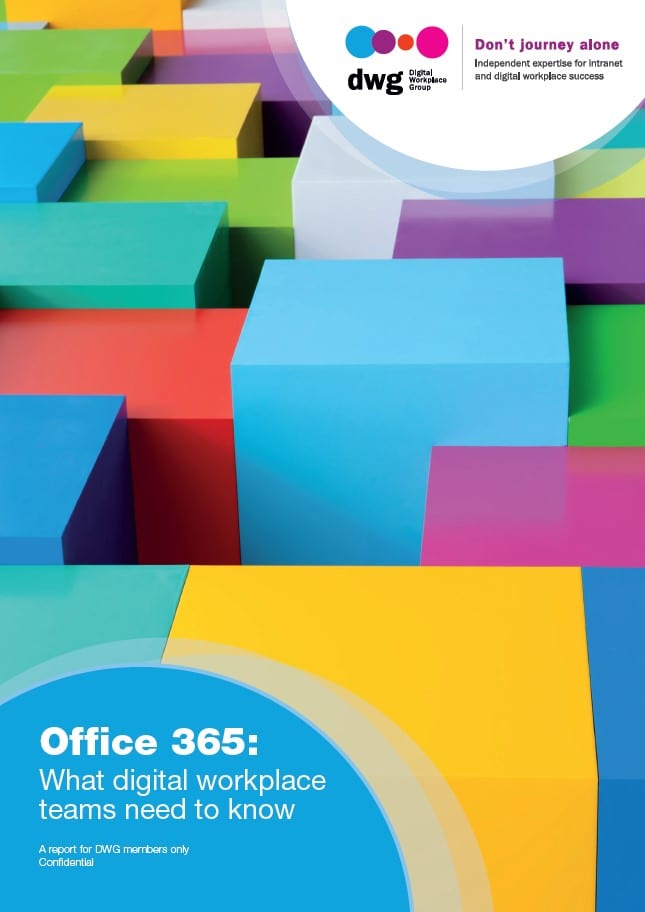What digital workplace teams need to know about Office 365: understanding the opportunities

Office 365 is Microsoft’s fastest growing commercial product ever.1 Recent DWG research found that 48% of organizations are already using it and an additional 15% planned to in the next year. Up to 40% of DWG members are planning to introduce Office 365 in the next 18 months.2
Microsoft is positioning Office 365 to respond to key trends in the digital workplace: remote work from anywhere, bring your own device (BYOD), shrinking IT budgets, cloud collaboration, and the “do more with less” mentality. Nonetheless, Office 365 Reporting tools remains absolutely essential. The cloud Office suite is advertised as “completely modernized to change the world of work.”3
Office 365 isn’t just SharePoint, and the digital workplace isn’t just the intranet. DWG research helps members articulate a vision for the digital workplace that reimagines the intranet as the integrated hub of a mobile, cloud-first digital user experience for your workforce. Many capabilities of Office 365 may be new to intranet teams. Exploring these potentially disruptive ideas can help you shape goals and build partnerships for the digital workplace whether you decide to adopt all, part or none of the Microsoft digital workplace platform.
Following on from DWG’s popular SharePoint reports, we have just published a new report “Office 365: What digital workplace teams need to know” that takes a deep dive into Office 365, looking at:
- business drivers and benefits
- challenges and risks
- opportunities and critical success factors
- the capabilities of Office 365
- leading examples of practice from DSM and dormakaba.
In this post we explore some of the opportunities for digital workplace teams.
Explore and experiment with key digital workplace capabilities
For organizations with a defined digital strategy and intranet roadmap, Office 365 provides some clear and compelling opportunities to deploy an integrated out-of-the-box digital workplace. However, since relatively few organizations have such a strategy or roadmap in place, Office 365 might best be seen as an invitation to explore and experiment with key digital workplace capabilities as agile phased rollouts, perhaps as part of a hybrid strategy for the short to medium term.
Upgrading email is where many organizations start with Office 365, when considering an upgrade to MS Exchange. It makes sense to look at the cloud capabilities of Office 365 and MS Azure for an enterprise email roadmap and, in many cases, email is the driving force behind an Office 365 deployment.
Desktop refresh and tablet/mobile support are two more opportunities to gain sponsorship for Office 365. A typical business user workstation may have a lifecycle of 2–4 years before either the hardware or the operating system needs to be replaced or updated.
OneDrive is often another early Office 365 adoption point, as an enterprise alternative to personal file sharing such as Dropbox or Box. Employees “bringing their own toolset” are increasingly using personal consumer accounts to work remotely or across devices. Providing an enterprise OneDrive can offer employees a more security-compliant solution for personal and team file sharing using their company account. Inviting HR and compliance teams to update the employee code of conduct for cloud file sharing is an opportunity to build cross-functional governance between Business and IT.
Extending an intranet to collaborate with customers or partners through secure extranet zones is also a very attractive use case. Organizations with security requirements to separate extranet services from on-premise SharePoint will appreciate the easy access to Office 365 without requiring access to an intranet inside the firewall. Extranet collaboration sites are well matched to SharePoint Online, since on-demand provisioning and business self-service are often more important than custom code or process automation.
Video is the new document
Video, they say, is the new document, and the Office 365 video portal makes it easy to provide a self-service video-hosting platform without the overhead of building media servers. For example, Weston Solutions is encouraging project managers to share three-minute videos made on their smartphones for training and knowledge transfer.4
Office 365 delivers a robust mobile experience in an area where many enterprises are experiencing pent-up demand. Mobile apps can support a digital workplace strategy that connects with both strategies for the physical workplace and people strategies for remote working and flextime. A consistent user experience across desktop, web, tablet and mobile reduces friction when switching across devices.
Making employee profiles actionable
Something as simple as presence status (a green dot when the user is online, red when in a meeting and grey when offline) and profile strength indicators can make employee profiles actionable in real time. If someone’s presence status is green, one click can send a quick instant message. If presence is grey, an email or voicemail may be a better way to communicate. If your profile is rated less than 100%, you may want to edit it to fill in missing data so that you show up more accurately in search results. Presence and profiles are gateways to social collaboration, and the hover cards for both Lync and Skype bring a rich profile experience to people search and unified communications.
Related research and resources
- Workplace by Facebook is rocket fuel for the digital workplace
- Six things the Digital Workplace Group has learnt about digital workplace maturity
- Six success factors for a personalized intranet
Office 365 Research
Arrange a call to learn more
Footnotes
1.http://www.cio.com/article/2873952/microsoft-office/microsoft-office-365-adoption-takes-off-war-with-google-apps-rages-on.html
2. DWG Member Survey
3. https://www.youtube.com/watch?v=3kfp6TaS9w4
4. http://members.digitalworkplacegroup.com/blogpost/439672/222136/Digital-Workplace-Live-Recording-Theopportunities-and-challenges-of-Office-365-with-Weston-Solutions?hhSearchTerms=%22weston
%22&terms=
Categorised in: Digital workplace, Research reports


